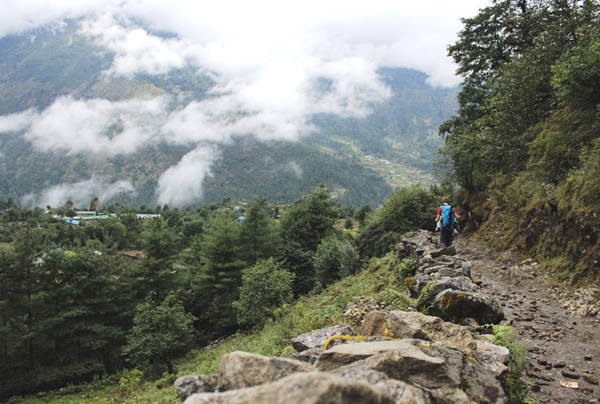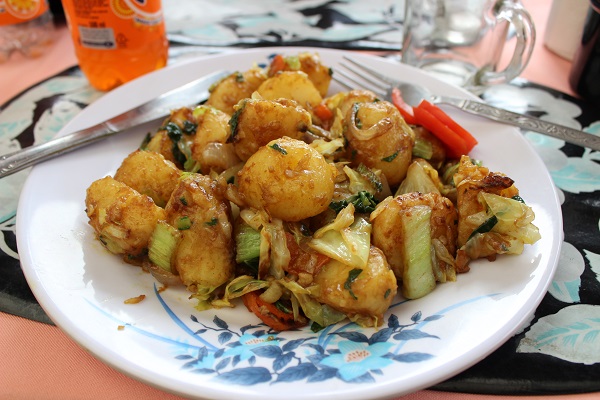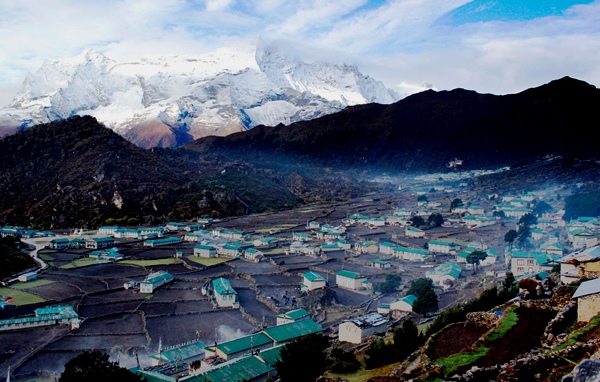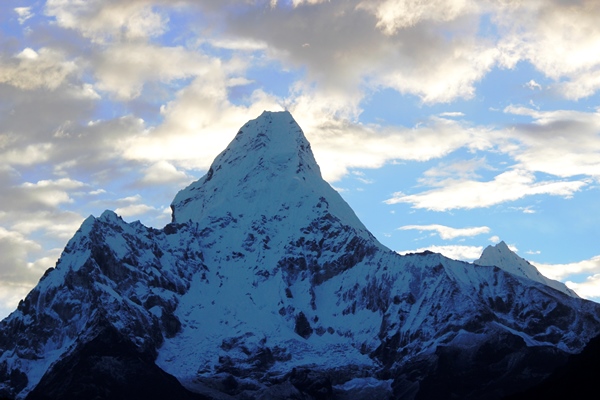
I’ve written quite a bit already about my trek to Gokyo Ri with travel photographer Peter West Carey and five others. Gokyo Ri is an alternative to the Everest Base Camp trek, starting from Namche Bazaar and then veering off in a different direction. In addition to keeping a journal during the trek, I kept track of all of the tiny details – what I ate each day, where we stayed each night and even what the temperature was in my room every morning when I woke up! So for those who are curious about the nitty gritty, here are some facts and figures for you:
What I Ate
I’ve mentioned before that the menus at most teahouses along the way are pretty much the same. Being gluten-intolerant meant my choices were even more limited, which left me consuming the following over a two-week period:
Oct. 2: Breakfast buffet at hotel in Kathmandu; Fried potatoes with veggies for lunch; chicken curry with rice for dinner.
Oct. 3: The smallest bowl of scrambled eggs I’d ever seen for breakfast; fried potatoes with veggies for lunch; pepper steak for dinner (in Namche Bazaar, where we could still get meat).
Oct. 4: Omelet with fried potatoes for breakfast (by the way, these are not French fries, they are cubed potatoes that have been sautéed with some veggies and a lot of garlic); vegetable fried rice with no soy sauce for lunch; French fries with two eggs on top for dinner.
Oct. 5: Omelet with fried potatoes for breakfast; hash brown potatoes with egg for lunch; tomato soup and French fries for dinner.
Oct. 6: Hash brown potatoes with egg for breakfast; vegetable fried rice, no soy sauce, for lunch; fried potatoes with two eggs for dinner.
Oct. 7: Scrambled eggs for breakfast; veggie fried rice, no soy sauce, for lunch; fried potatoes with two eggs and a fruit cup for dinner.
Oct. 8: Two fried eggs and French fries for breakfast; hash brown potatoes with eggs for lunch; mashed potatoes with egg for dinner (so many eggs!!)

Oct. 9: Omelet and French fries for breakfast; rice pudding with sugar and cinnamon and plain rice for lunch; fried rice with egg, no soy sauce, for dinner.
Oct. 10: Horribly salty tomato omelet and a plain omelet for breakfast; popcorn for lunch (I couldn’t handle anything else!); mashed potatoes and a luckily not-so-salty tomato omelet for dinner.
Oct. 11: Omelet and French fries for breakfast; vegetable curry rice for lunch; Russian salad and mashed potatoes with roasted veggies for dinner.
Oct. 12: Scrambled eggs and French fries for breakfast; vegetable fried rice, no soy sauce, for lunch; boiled potatoes with cheese and boiled veggies for dinner.
Oct. 13: Two boiled eggs and French fries for breakfast; super delicious chicken curry with rice for lunch; chicken curry with rice again for dinner (it was just so good!).
Oct. 14: French fries and an omelet for breakfast; popcorn and plain rice for lunch; chicken kebab with rice and salad for dinner.
Oct. 15: Omelet and French fries for breakfast; fried potatoes with veggies for lunch; carrot and cabbage salad and chicken curry with rice for dinner.
Oct. 16: Scrambled eggs and French fries for breakfast; chicken steak with veggies and fries for lunch; dal bhaat (traditional Nepali dish) for dinner.
Is it any wonder I pigged out on plates and plates of chicken curry and chicken tikka masala when I returned to Kathmandu? Not to mention the bacon, sausage and fruit in the breakfast buffet at our Kathmandu hotel!!
Where We Stayed
I thought our guide did a pretty good job of scoring us quality places to stay along the way. We enjoyed decent showers every other day or so, a good number of Western toilets and loads of thick, warm blankets!
Phakding: Tashi Tagey Lodge – on the main drag as you enter town, it featured an indoor, Western toilet that flushed and a sink with running water and a mirror. The rooms were connected to the heated dining room, so no need to go outside.
Namche Bazaar (2 nights): Camp de Base – on the hill, it was not fun to get to after a long day of hiking! But, we enjoyed private rooms with attached bathrooms (including hot showers!) and electrical outlets in the rooms. They also offered a 24 hour laundry service. Big bummer was having to go outside to get to the dining hall.
Khumjung: Hilltop View – owned by our Sherpa Kami’s in-laws, we got the VIP treatment here. There was a squat toilet and a Western style toilet available and the dining hall was small and heated up quickly. They also had clotheslines hanging around the stove to dry clothing and the best popcorn of any teahouse we stayed at.
Mong La: Hilltop Resto – A much better than expected “bucket” shower, which was fortunately right next to our rooms, so there was no need to go outside after showering (although the hallway was still chilly!). Unfortunately, no Western-style toilet, just a squatter.
Dole: Dole Guest House – This was the first place we stayed at that was solely solar-powered, so as soon as the sun went down, the lights did as well. While it did have a Western-style toilet, you had to go outside to get to it. It also lacked any kind of sink or other place to wash your face or brush your teeth.

Machermo: Tashi Dele – I didn’t try out the showers here, but one of the guys in my group said the water pressure was so bad it wasn’t even really worth showering. That said, there was a faucet in the yard that people used to wash everything from dishes to clothing to themselves. However, no Western-style toilets or working sinks.
Gokyo (2 nights): Cho Yu – Arguably the best place we stayed! Our rooms were on the second floor of the teahouse, with wide windows facing out at the third of the Gokyo Lakes. They also got the afternoon sun, which meant my afternoon nap was actually warm! A shower was available as well, although you had to step outside as soon as you were finished. Note that this was one place where we saw people turned away because they were not with a guide.
Dole (again): Yeti Inn – we stayed on the opposite, more “touristy” side of the spring on our way down. The Yeti Inn was luxurious in some ways – doors with real locks, a Western-style toilet indoors that actually flushed (the others you had to pour water into to flush them) and a sink with running water. The dining hall was also small and crowded, which kept it warm.
Pengboche: Trekkers Holiday Inn – Home of the Best. Shower. Ever. The only gas-heated shower we enjoyed outside of Namche, this was simply awesome. I never wanted to leave. As a bonus, the rooms were upstairs from the dining hall, which meant the heat from the stove rose up to the rooms and kept them relatively warm for most of the night. If it wasn’t for the most disgusting squat toilet ever, this place would have been perfect.
Tengboche: Tengboche Guest House – Probably the smallest rooms we encountered anywhere, the rooms were at least leak proof – that was tested as it rained nonstop the whole time we were there. It also featured very clean toilets, both Western and squat, and a sink and mirror inside.
Namche (again): Zamling Guest House – The good thing about this lodge is that it is at the top of the hill, so arriving in Namche, we didn’t have far to go. That’s also the bad thing, as getting into the center of town was quite a hike. We enjoyed private rooms with showers, bathtubs and electrical outlets, which was awesome, but we had to go up two flights of stairs and outside to get to them. When you’ve been trekking for 12 days and it is pouring rain, this is not ideal. On the good side again, though, they had an actual working drying machine to dry our clothes, decent wifi in the dining hall and good food.
Phakding (again): Tashi Tagey Lodge (again) – this time around, we enjoyed their “private” dining room, which kept us ridiculously warm, and their portable DVD player, which we used to watch Everest in celebration of our last night on the trail.
Lukla: Lukla Numbur Hotel – located right next to the airport, this lodge was like staying in a real hotel again. It was quite convenient for our early morning departure and we could even watch the planes landing just outside the window. On the other hand, getting to the shops in the main part of town required a minor trek up and around the airport.

How Cold Was It?
Finally, a look at how cold it got overnight throughout the trek. None of our rooms were heated and we relied on thick blankets to keep us warm. I had a thermometer on my travel alarm clock, so I checked it every morning (usually around 5 or 5:30 a.m.) to see just how chilly it was!
Oct. 2: Phakding – 2610 meters – 63 degrees Fahrenheit
Oct. 3: Namche Bazaar – 3440 m. – 55 degrees
Oct. 4: Namche – 59 degrees
Oct. 5: Khumjung – 3780 m. – 49.5 degrees
Oct. 6: Mong La – 3957 m. – 46 degrees
Oct. 7: Dole – 4058 m. – 43.8 degrees
Oct. 8: Machermo – 4393 m. – 45.4 degrees (warmer!)
Oct. 9: Gokyo – 4759 m. – 38.5 degrees
Oct. 10: Gokyo – 32.8 degrees (brrrr!)
Oct. 11: Dole – 39.4 degrees
Oct. 12: Pengboche – 4007 m. – 53.9 degrees
Oct. 13: Tengboche – 3857 m. – 49.4 degrees (I think the nonstop rain affected this!)
Oct. 14: Namche – 3440 m. – 54.7 degrees
Oct. 15: Phakding – 58 degrees (like a heat wave after Gokyo!)
If you’re planning to go, keep in mind that I was trekking in the first half of October. Temperatures will continue to get colder as you get into November and December.

Also Worth Noting…
I took 6 showers over 14 days – in Namche, Mong La, Gokyo, Pengboche, again in Namche and then in Lukla before flying back to Kathmandu.
I washed clothes just twice – in Namche and then in Gokyo about halfway through. I packed 3 pairs of hiking pants, 6 short sleeve shirts, 4 long sleeve shirts, 3 sweatshirts/fleeces, 6 pairs of socks, 10 pairs of undies, 2 sports bras, a rain jacket, a pair of pajama pants and a pair of leggings.
I wore four layers for the hike up to Gokyo Ri to watch the sun rise.
I was down to a single layer by the time I headed back down.
I drank approximately five dozen cups of lemon tea.
I brought two 1-pound bags of almonds to snack on but only finished one.
I went through two rolls of toilet paper.
I went through about six packages of tissues.
I had to replace the batteries for my SteriPen once.
I took about 3000 pictures.
And I went ten full days without accessing the internet – even though I could have.
